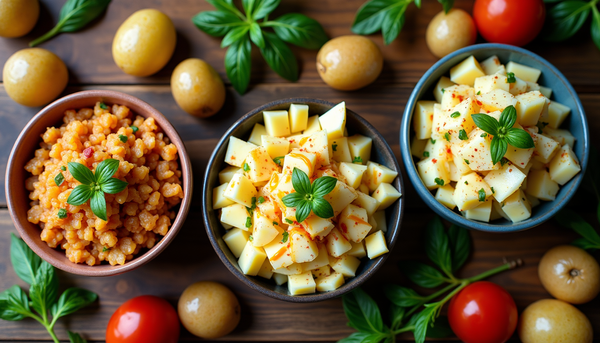Why Your Grandma's Applesauce Cake Is Actually Revolutionary

So I'm scrolling through yet another cookbook (yes, I have a problem), when this applesauce cake recipe stops me dead in my tracks. Not because it looks particularly fancy—honestly, it's pretty humble looking. But because it made me realize something kinda wild: our grandmas were basically food scientists, and we had no idea.
Let me explain.
The Accidental Genius of Depression-Era Baking
Applesauce cake isn't just some random dessert your great-aunt Mildred used to make. It's literally a masterpiece of ingredient substitution born out of necessity. Picture this: it's the 1930s, butter and eggs are expensive (or rationed), and you've got a bunch of apples that need using before they go bad. What do you do? You get creative.
The thing is, what started as "making do" accidentally created something better than the original. Applesauce doesn't just replace fat—it adds moisture, natural sweetness, and this subtle fruity complexity that butter never could. It's like when you're trying to save money by making coffee at home and accidentally discover you prefer it to Starbucks. Sometimes constraints breed innovation.
But here's where it gets really interesting. That A Couple Cooks recipe I mentioned? It's basically a modern love letter to this Depression-era ingenuity, tweaked for our contemporary pantries and health consciousness.
Deconstructing the "Simple" Recipe
Okay, let's talk about why this isn't actually simple at all. The recipe calls for:
- Applesauce (obviously)
- Greek yogurt
- Neutral oil
- Brown sugar instead of white
- A spice blend that reads like a medieval apothecary
Each ingredient choice is doing multiple jobs. The Greek yogurt? That's adding protein and tang while keeping things moist. The oil instead of butter? More consistent moisture distribution. Brown sugar? Complex molasses notes that play nice with the spices.
And those spices—cinnamon, allspice, cloves, ginger—they're not just flavor. They're preservatives. Before refrigeration, spices helped extend shelf life. Your ancestors were basically adding natural preservatives while making everything taste amazing.
I tried this recipe three times before I got it right, btw. First time, I overmixed the batter because I'm an anxious person who doesn't trust "just until combined." Result? Dense, chewy disaster that my roommate kindly described as "interesting texture."
Second time, I used chunky applesauce because that's what I had. Pro tip: don't. Unless you enjoy surprise pockets of mushy apple interrupting your cake experience.
Third time? Chef's kiss. Finally understood why the cookbook emphasized not overmixing. The cake was tender, spiced perfectly, and that sour cream glaze? Game changer. Tangy enough to cut through the sweetness but not so much that it tastes like you accidentally used ranch dressing.
The Evolution Game
Here's what fascinates me about recipes like this: they're living documents. The original applesauce cakes used whatever spices were available and white sugar if you were lucky. Today's version incorporates Greek yogurt (didn't exist in mainstream American kitchens until the 2000s), neutral oils (hello, avocado oil), and brown sugar (once considered inferior, now trendy).
Each generation adapts based on what's available, what's affordable, and what's considered healthy. My mom's generation added nuts and raisins because that's what you did in the 80s. Millennials are probably gonna start adding adaptogens or some shit. (Actually, don't give me ideas...)
The point is, there's no "authentic" version. There's just the version that works for your time, your budget, your dietary needs, and your taste preferences.
Real Talk: Why This Recipe Actually Works
Beyond the historical romanticizing, this cake delivers on multiple levels:
Moisture game is strong. Three different moisture sources (applesauce, yogurt, oil) mean this cake stays tender for days. In our dry-ass apartments with terrible heating, that's not nothing.
Spice complexity without fussiness. You probably have most of these spices already, and the combination creates this warm, cozy flavor that's sophisticated without being pretentious. It's like the baking equivalent of a really good vintage sweater.
Flexible as hell. Out of Greek yogurt? Use sour cream. No brown sugar? White sugar plus a tablespoon of molasses works. Missing cloves? Double the allspice. The recipe is forgiving because it evolved from people who had to be resourceful.
Actually gets better overnight. Unlike most cakes that peak on day one, this one improves as the flavors meld. Perfect for weekend baking when you want something to look forward to with Monday morning coffee.
The Glaze Situation
Can we talk about this sour cream glaze for a second? It's basically the anti-buttercream. Where buttercream is sweet and rich and sometimes overwhelming, this glaze is tangy and light and somehow makes you want another slice instead of a nap.
The recipe calls for just three ingredients: powdered sugar, sour cream, vanilla. That's it. But the ratio is everything. Too much sour cream and it's runny. Too little and it's paste. The sweet spot creates this pourable-but-not-too-thin consistency that sets just enough to not slide off but stays creamy.
I've started putting this glaze on everything. Banana bread, muffins, my Monday morning existential crisis. It fixes most problems.
Modern Adaptations Worth Trying
Since we're not bound by Depression-era limitations, here are some variations I've been experimenting with:
The Fancy Version: Add a tablespoon of bourbon to the batter and use maple syrup instead of some of the brown sugar. Very Brooklyn gastropub vibes.
The Healthy-ish Version: Substitute half the flour with almond flour, use coconut sugar instead of brown sugar. It's not health food, but it's not not health food.
The Extra Version: Add cardamom and orange zest to the batter, make the glaze with cream cheese instead of sour cream. This is what you make when you want people to think you went to culinary school.
The Nostalgic Version: Fold in chopped walnuts and a handful of raisins plumped in apple cider. Very 1970s church potluck energy.
Why This Matters (Besides Cake)
Look, I know I'm getting deep about applesauce cake, but hear me out. In our Instagram-perfect, sourdough-starter, artisanal-everything food culture, there's something radical about embracing recipes that prioritize practicality over aesthetics.
This cake isn't going to photograph beautifully for your feed. It's brown, it's simple, it looks like something your aunt would bring to a family gathering in a disposable aluminum pan. And that's exactly why it's important.
These recipes carry forward the wisdom of generations who understood that good food doesn't have to be complicated or expensive or photogenic. It just has to nourish people and bring them together.
Every time we make these older recipes—and adapt them to our current lives—we're participating in this ongoing conversation across generations. We're proving that the best innovations often come from constraints, that necessity really is the mother of invention, and that sometimes the most radical thing you can do is appreciate something simple done really, really well.
Your Assignment (If You Choose to Accept It)
Make this cake. But here's the twist: don't follow the recipe exactly. Change something. Use what you have on hand. Adapt it to your dietary needs or preferences or what's in your pantry on a random Tuesday.
Then think about what you changed and why. What does your version say about your life, your priorities, your available ingredients? How is your applesauce cake different from your grandmother's, and what does that difference reveal?
Share your adaptations—I'm genuinely curious how this recipe evolves in different kitchens. Tag me if you want, or don't. Just make the cake and think about the bigger picture while you're licking the bowl.
Because at the end of the day, that's what good recipes do. They feed us, sure. But they also connect us to the long chain of humans who've been figuring out how to make something delicious from whatever they had on hand.
And honestly? That's pretty revolutionary.
PS: If you overmix the batter and it turns out dense, just call it "rustic" and serve it with extra glaze. Sometimes the best recipes come from beautiful mistakes.




